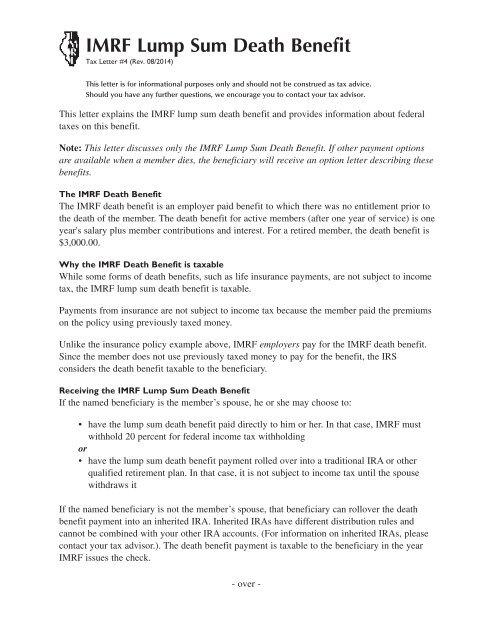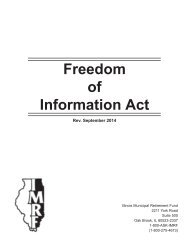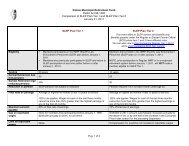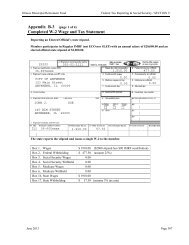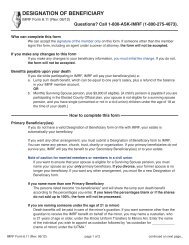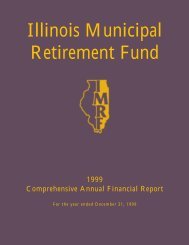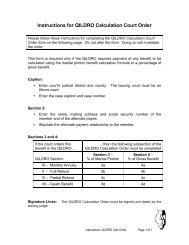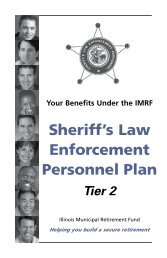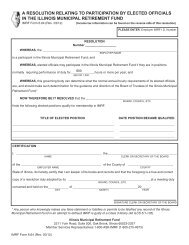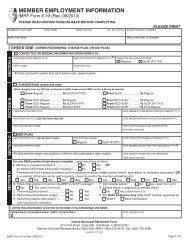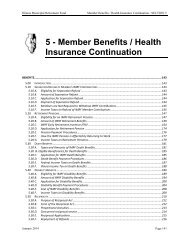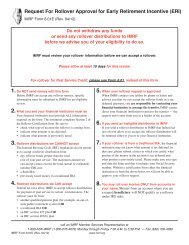IMRF Lump Sum Death Benefit
IMRF Lump Sum Death Benefit
IMRF Lump Sum Death Benefit
- No tags were found...
You also want an ePaper? Increase the reach of your titles
YUMPU automatically turns print PDFs into web optimized ePapers that Google loves.
<strong>IMRF</strong> <strong>Lump</strong> <strong>Sum</strong> <strong>Death</strong> <strong>Benefit</strong>Tax Letter #4 (Rev. 08/2014)This letter is for informational purposes only and should not be construed as tax advice.Should you have any further questions, we encourage you to contact your tax advisor.This letter explains the <strong>IMRF</strong> lump sum death benefit and provides information about federaltaxes on this benefit.Note: This letter discusses only the <strong>IMRF</strong> <strong>Lump</strong> <strong>Sum</strong> <strong>Death</strong> <strong>Benefit</strong>. If other payment optionsare available when a member dies, the beneficiary will receive an option letter describing thesebenefits.The <strong>IMRF</strong> <strong>Death</strong> <strong>Benefit</strong>The <strong>IMRF</strong> death benefit is an employer paid benefit to which there was no entitlement prior tothe death of the member. The death benefit for active members (after one year of service) is oneyear's salary plus member contributions and interest. For a retired member, the death benefit is$3,000.00.Why the <strong>IMRF</strong> <strong>Death</strong> <strong>Benefit</strong> is taxableWhile some forms of death benefits, such as life insurance payments, are not subject to incometax, the <strong>IMRF</strong> lump sum death benefit is taxable.Payments from insurance are not subject to income tax because the member paid the premiumson the policy using previously taxed money.Unlike the insurance policy example above, <strong>IMRF</strong> employers pay for the <strong>IMRF</strong> death benefit.Since the member does not use previously taxed money to pay for the benefit, the IRSconsiders the death benefit taxable to the beneficiary.Receiving the <strong>IMRF</strong> <strong>Lump</strong> <strong>Sum</strong> <strong>Death</strong> <strong>Benefit</strong>If the named beneficiary is the member’s spouse, he or she may choose to:• have the lump sum death benefit paid directly to him or her. In that case, <strong>IMRF</strong> mustwithhold 20 percent for federal income tax withholdingor• have the lump sum death benefit payment rolled over into a traditional IRA or otherqualified retirement plan. In that case, it is not subject to income tax until the spousewithdraws itIf the named beneficiary is not the member’s spouse, that beneficiary can rollover the deathbenefit payment into an inherited IRA. Inherited IRAs have different distribution rules andcannot be combined with your other IRA accounts. (For information on inherited IRAs, pleasecontact your tax advisor.). The death benefit payment is taxable to the beneficiary in the year<strong>IMRF</strong> issues the check.- over -
How to Report on IRS Form 1040 or 1040AIf you receive a death benefit payment from <strong>IMRF</strong>, you would report this payment on thepension line of IRS Form 1040 or 1040A. On the 2002 form this is line 16 on IRS Form 1040and line 12 on IRS Form 1040A. The pension line of these forms has two boxes. For theexamples below, we will refer to these as “Box a” and “Box b.”“Box a” is for the gross amount received, and “Box b” is for the taxable portion of thepayment. For our examples we will assume that there was only one beneficiary with no otherpension or death benefit payments.Note: If there were additional pension or death benefit payments, you would add thosepayments to the amounts shown in our examples.• $15,000 <strong>Death</strong> <strong>Benefit</strong> – Entire amount paid to you, you roll nothing overBox 1 (gross distribution) on IRS Form 1099-R shows the $15,000 death benefit. Box2a (taxable amount) on IRS Form 1099-R also shows the $15,000 death benefit. Includethe amount from Box 1 on the 1099-R in Box a on the 1040/1040A. Include the amountfrom Box 2a on the 1099-R in Box b on the 1040/1040A.• $15,000 <strong>Death</strong> <strong>Benefit</strong> - $8,000 paid to you, you roll over $7,000In this case you received two IRS Forms 1099-R from <strong>IMRF</strong>. One for the $7,000 yourolled over into an IRA or qualified retirement plan, and one for the $8,000 which youdid not roll over. To complete the IRS Form 1040 or 1040A, you add together thefigures given on both Forms 1099-R.Box 1 (gross distribution) from both IRS Forms 1099-R would total $15,000. Box 2a(taxable amount) from both IRS Forms 1099-R would total $8,000 ($15,000 less the$7,000 rolled over).Show the total death benefit of $15,000 in Box a on IRS Form 1040 or 1040A and show$8,000 in Box b.Information about payments from pension plans can be found in IRS Publication 575, “Pensionand Annuity Income.” You can obtain this publication on the IRS web site at www.irs.gov or bycalling 1-800-TAX_FORM (1-800-829-3676). If you have questions about the <strong>IMRF</strong> deathbenefit, please call an <strong>IMRF</strong> Member Service Representative at 1-800-ASK-<strong>IMRF</strong>(1-800-275-4673).Illinois Municipal Retirement FundMember Service Representatives 1-800-ASK-<strong>IMRF</strong> (1-800-275-4673)<strong>IMRF</strong> Tax Letter #4 (Rev. 08/2014)


